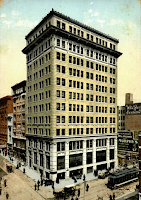A few weeks ago marked the 109th anniversary of the Great Fire of Baltimore. This week, the Union Trust Building (currently designated as the Jefferson Building) at 101 N. Charles Street, northeast Fayette St corner, which was once destined to be a Staybridge Suites hotel and has been in bank foreclosure. A display banner was draped around the corner of its first floor announcing the auction this week noting its “historic” in nature.
For the nostalgic types and historic preservationists that know just what this building has been through, it’s somewhat sad given that this rather visually uninteresting building is in the truest sense of the word, a “survivor.”
The Union Trust Building was originally known as the Massachusetts Building Company's building. It was built for $550,000 in early 1899 by the architectural firm Winslow & Wetherill of Boston and then sold to the Atlantic Trust and Deposit Company. It later transferred to the Union Trust Company in April 1901 and became known as the Union Trust Building.
On Sunday, February 7th 1904, this eleven-story building, which was originally built a mere five years earlier, stood in the retail district amidst stores filled with much flammable material only to be subjected to a historic fire. The fire which started a mere four blocks away at the dry goods warehouse of the John E. Hurst Company (at the present southwest corner of Hopkins Place and German Street) reached peak intensity as it approached the Union Trust building. According to Fireproof Magazine, March 1904, nearly all authorities on the subject agreed that the Union Trust building was exposed to the severest test of any of the skyscrapers during the Great Fire of Baltimore.
The building on the opposite corner at the time was completely destroyed by dynamiting in advance of the fire, but that action also had the result of breaking the glass out of every window in the Union Trust building. According to eyewitness accounts, “for a moment the explosion seemed to deaden the fire and stop its approach, then a burst of flames, rising up from the ruins several hundred feet, lapped across the street and in the same moment entered every window on the two street fronts of the Union Trust building.”
Since the Union Trust was designed with a central open stairway surrounded on three sides by a corridor extending the entire height of the building, the entering flames raced up what was essentially a great flue for the escape of the fire – in forty minutes there was nothing left but a blackened shell of the building.
Despite nearby dynamiting and the intense fire burning throughout it, “the Union Trust Building must be given credit for having stood as the Gibralter” against the waves of fire which finally broke in vain and the fire reached its most northern point here. Unlike the Continental Trust Building, another of the only 10 building survivors from that fire, the Union Trust’s cast iron mullions were in good condition whereas in the former they were almost a total loss. An engineering expert was said to have deemed that the Union Trust’s 800 tons of structural steel was salvageable at 100 percent despite there being a near full incineration of everything else inside.
The Union Trust Building was originally known as the Massachusetts Building Company's building. It was built for $550,000 in early 1899 by the architectural firm Winslow & Wetherill of Boston and then sold to the Atlantic Trust and Deposit Company. It later transferred to the Union Trust Company in April 1901 and became known as the Union Trust Building.
 |
| Union Trust Building, c1902 Courtesy: CardCow Postcards |
On Sunday, February 7th 1904, this eleven-story building, which was originally built a mere five years earlier, stood in the retail district amidst stores filled with much flammable material only to be subjected to a historic fire. The fire which started a mere four blocks away at the dry goods warehouse of the John E. Hurst Company (at the present southwest corner of Hopkins Place and German Street) reached peak intensity as it approached the Union Trust building. According to Fireproof Magazine, March 1904, nearly all authorities on the subject agreed that the Union Trust building was exposed to the severest test of any of the skyscrapers during the Great Fire of Baltimore.
The building on the opposite corner at the time was completely destroyed by dynamiting in advance of the fire, but that action also had the result of breaking the glass out of every window in the Union Trust building. According to eyewitness accounts, “for a moment the explosion seemed to deaden the fire and stop its approach, then a burst of flames, rising up from the ruins several hundred feet, lapped across the street and in the same moment entered every window on the two street fronts of the Union Trust building.”
Since the Union Trust was designed with a central open stairway surrounded on three sides by a corridor extending the entire height of the building, the entering flames raced up what was essentially a great flue for the escape of the fire – in forty minutes there was nothing left but a blackened shell of the building.
 |
| 1904 Great Fire Ruins Surrounding Union Trust Building |
 |
| 700 pound stress test, April 20, 1904 |
Two months later, on April 20, 1904, tests were accomplished on the second floor structure of the Union Trust by loading with 700 pounds of lumber to which it successfully passed with full integrity. Here's hoping that the Union Trust building can withstand the test of new owner and somehow rise beautifully again in Baltimore like a phoenix from its economic ashes.
(Sources: Enoch Pratt Free Library Photograph Collection,
Maryland Digital Cultural Heritage, Fireproof Magazine (March 1904))
















